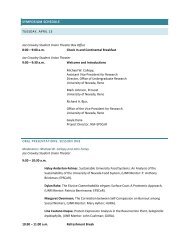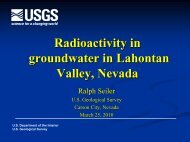Student Research Programs - Office of Undergraduate and ...
Student Research Programs - Office of Undergraduate and ...
Student Research Programs - Office of Undergraduate and ...
You also want an ePaper? Increase the reach of your titles
YUMPU automatically turns print PDFs into web optimized ePapers that Google loves.
DMD mouse model (mdx) as compared to wild-type animals. Galectin-3 has been associated with the extracellular<br />
matrix <strong>of</strong> cells <strong>and</strong> has been effectively used as a biomarker to monitor the progression <strong>of</strong> several other disease<br />
types, including numerous cancers. Therefore, our work demonstrates one possible biomarker for MDC1A <strong>and</strong><br />
DMD, which may be monitored through minimally invasive methods (blood collection) or noninvase methods<br />
(urine collection).<br />
A DETERMINATION OF THE EFFECT OF DOCOSAHEXAENOIC ACID ON CELL DIFFERENTIATION AND<br />
INVASION IN CANCER CELLS<br />
Palvinder Bains<br />
Program: NIH INBRE<br />
Mentor: Keith Kikawa<br />
Department: Biochemistry <strong>and</strong> Molecular Biology<br />
University <strong>of</strong> Nevada, Reno<br />
When grown on an extracellular matrix substrate like Matrigel, cell lines most<br />
<strong>of</strong>ten demonstrate differentiation patterns <strong>and</strong> form spheroids. However, the<br />
most aggressive cancer cell lines (i.e. A549) <strong>of</strong>ten exhibit a branching phenotype<br />
more typical <strong>of</strong> fibroblasts. Docosahexaenoic acid (DHA) is an omega-3<br />
polyunsaturated fatty acid (PUFA) known to inhibit the growth <strong>of</strong> a number <strong>of</strong><br />
cancer cell lines, including the human lung adenocarcinoma cell line, A549, while<br />
the omega-6 PUFA, linoleic acid (LA), upregulates growth in the same cell lines.<br />
However, it was previously unknown whether the inhibitory effects <strong>of</strong> PUFAs extend to alterations in cell<br />
differentiation <strong>and</strong> invasion. In the current study, the growth <strong>of</strong> the A549 <strong>and</strong> BT-474 human ductal carcinoma<br />
cell line on Matrigel was examined in response to DHA <strong>and</strong> LA supplementation. Interestingly, while DHA<br />
inhibited even spheroid formation <strong>and</strong> growth <strong>of</strong> both cell lines, LA greatly enhanced cell branching in A549 cells.<br />
Moreover, when cell invasion was measured, LA very significantly increased the percentage <strong>of</strong> cells invading,<br />
while DHA demonstrated slight decreases. Future studies will examine the effects <strong>of</strong> DHA <strong>and</strong> LA on cell<br />
differentiation in non-transformed cell lines <strong>and</strong> perform a survey <strong>of</strong> extracellular matrix proteins like vinculin <strong>and</strong><br />
e-cadherin. The current data suggests PUFAs can alter cell invasiveness <strong>and</strong> growth on Matrigel providing<br />
important insight to establish new approaches for the treatment <strong>of</strong> cancer.<br />
LAUNCHING NANO-SIZED SPHERICAL GLASS BEADS INTO AN OPTICAL TRAP<br />
Melanie Beck<br />
Program: NSF EPSCoR<br />
Mentor: Andrew Geraci<br />
Department: Physics<br />
University <strong>of</strong> Nevada, Reno<br />
There are currently multiple efforts to establish whether or not nonNewtonian<br />
gravitational forces exist when measured on a scale <strong>of</strong> microns. In order to increase<br />
force detection on such small scales it has been proposed to trap <strong>and</strong> levitate a<br />
nanometer-sized glass bead in an optical cavity in an ultrahigh vacuum. An object<br />
near a dense mass will experience a deflection. Precise measurements <strong>of</strong> this<br />
deflection could yield the existence <strong>of</strong> exotic new gravitational forces. Due to<br />
levitation, the bead’s motion would not be hindered by friction from surface<br />
contact nor from collisions with air molecules due to the ultrahigh vacuum. Extraordinarily sensitive<br />
measurements could be achieved. As a first step toward this goal, I propose to construct a device capable <strong>of</strong><br />
6











